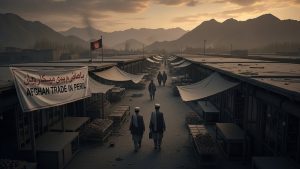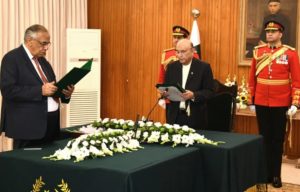The Regional Cooperation for Development (RCD) was established in 1964 by Iran, Pakistan, and Turkey. The organisation subsequently changed its name to the Economic Cooperation Organisation (ECO) in 1985 for regional integration of trade and commerce. The number of member-states increased from three founding states to ten, including five Central Asian States, Azerbaijan and Afghanistan. The headquarters of ECO is located in Tehran, Iran.
The ECO region has the advantage of direct land linkages with every member state that shares similar cultural, religious, and historical connections. It covers 8 million square kilometres of land, connecting North to South and Europe to the Arab world. With the increased socioeconomic and political development in global and regional trade, ECO aims to consolidate the multilateral trade potential of member states to enhance economic cooperation. It has subsidiaries like ECO Trade & Development Bank, ECO Chamber of Commerce & Industry, and Center for Implementing ECO Trade Agreement (ECOTA). They play an important role in the coordination and function of the organisation. Yet, despite these factors, the economy of ECO nations has not experienced a breakthrough comparable to that of its counterpart organisations like the Association of South-East Asian Nations (ASEAN) and the European Union (EU). This insight attempts to find shortcomings in the economic integration of the ECO region.
With their vast natural resources and human capital, the ECO member nations hold immense potential for regional economic growth. Regional organisations, with their more efficient and profitable means of trade and economic activity, are a promising avenue for the ECO region. With a population of more than 500 million and a collective GDP of 2 trillion dollars, the ECO region’s true potential for intra-regional trade is yet to be fully realised.
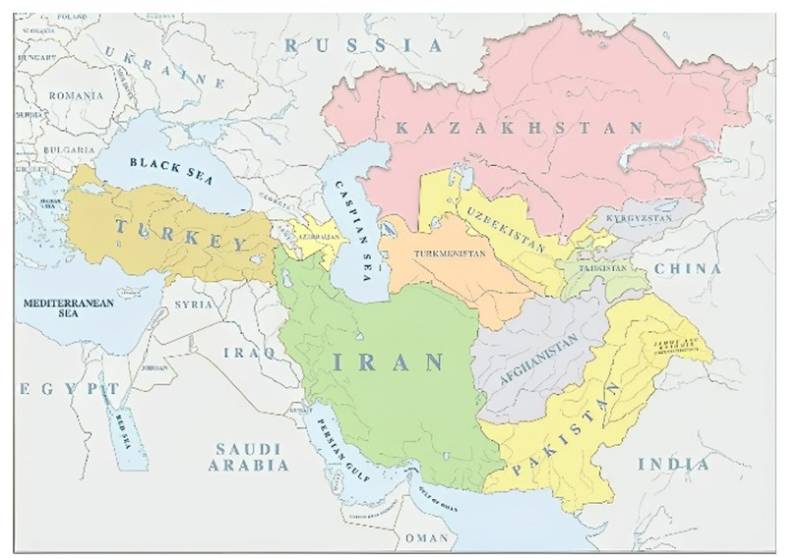
Trade is a key factor in economic growth and can potentially advance the economies of the ECO region significantly. However, the current weak regional trade frameworks and relatively low trade volumes compared to other extra-regional nations are urgent issues that must be addressed. The ECO region, among the least economically integrated regions in the world, must act swiftly to improve its economic integration.
Graph 1 shows an increase in total ECO regional trade from US$59 billion in 2018 to US$83 billion in 2022. Although total intra-regional trade has increased steadily from 2018 to 2022, the ECO’s collective intra-regional trade is only 8% (US$83 billion) of its total trade value with the outside world (US$1037 billion).
Graph 1
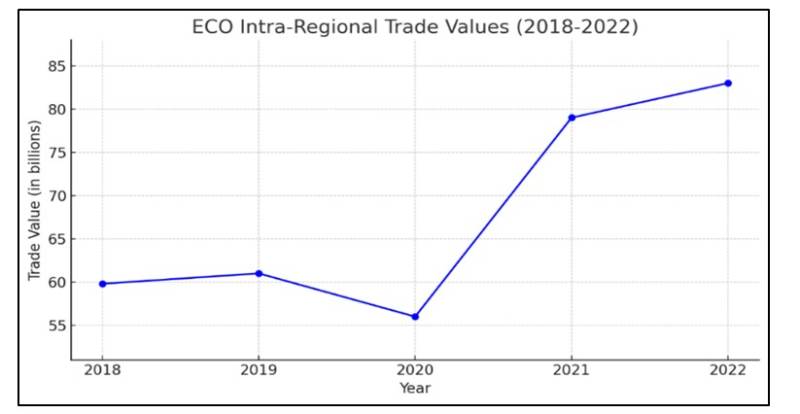
Source: UN Comtrade Data Base
Graph 2 shows the volume of intra-regional trade by each member state from 2018 to 2022. Turkey has contributed the most to the intra-regional trade, followed by Kazakhstan and Uzbekistan. Pakistan only shared around US$4 billion out of the US$83 billion total trade of the ECO region, which hardly made 5% in 2022.
Graph 2
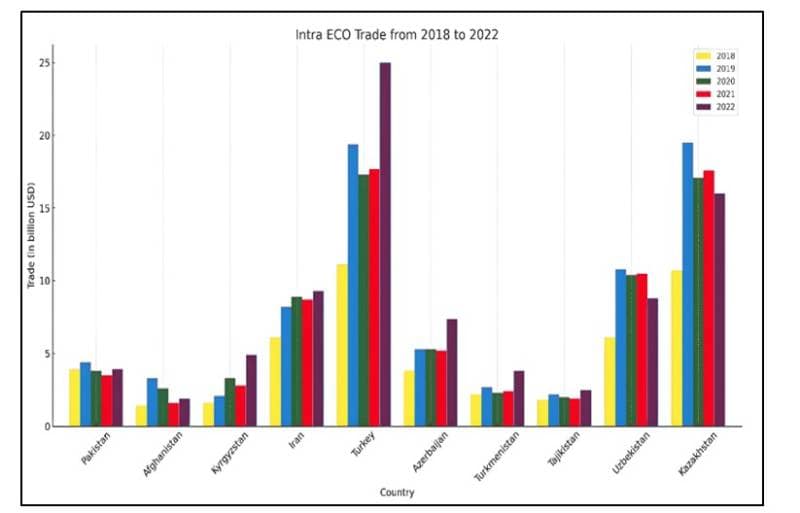
Source: UN Comtrade Data Base
Even though Pakistan is connected through a land route with all the ECO member states, its exports to these countries hardly amount to any substantial percentage. The ECO potential is affected by the US sanctions on Iran and Afghanistan that prevent substantive engagement in trade agreements. These geopolitical challenges hinder the advancement of broader regional trade integration.
The small size of the intra-regional trade is attributed to many reasons. ECO deals with a weak integrated monetary framework to facilitate tariff-free trade. The absence of an institutional framework creates obstacles in providing policy assistance and implementation for trade. Organisations like ASEAN have established Free Trade Areas (FTA) to facilitate trade, with lower tariffs and non-tariff trade barriers among member countries. ECO has a fragmented and underdeveloped institutional framework that impedes regional cooperation compared to ASEAN.
ASEAN introduced the ASEAN Economic Community (AEC), which established a single market production base, allowing the free flow of goods, investment, and skilled labour. This created a diverse market for regional integration similar to the EU-style common market. ECO economies can employ a similar strategy in diversifying their economy from energy exports to the manufacturing industry by establishing similar community hubs.
ASEAN and ECO regions have diverse economic bases that increase intra-regional trade prospects. In ASEAN, countries like Singapore provide financial services and high-tech industries, Indonesia has natural resources, Thailand focuses on automobile manufacturing, and Vietnam focuses on textiles and consumer products. Because of this diverse manufacturing industry and demand, there are brighter prospects for intra-region trade in ASEAN. Similarly, in ECO, member states like Iran, Kazakhstan, Turkmenistan, and Azerbaijan have energy resource base encompassing a significant part of their economies. Other members, like Turkey, have a strong manufacturing industry that provides products such as electric machinery and heavy vehicles, followed by Pakistan’s agricultural and textile exports. Tajikistan and Uzbekistan possess vast mineral reserves like precious metal ore and gold. This economic base provides an opportunity to improve intra-regional trade by utilising regional resources without importing from other countries.
The ECO member nations possess vast natural resources and human capital. Regional organizations provide a more efficient and profitable means of trade and economic activity than bilateral relations.
To address these issues, especially for improving regional trade among member states, the ECOTA was signed in 2003 to remove bureaucratic hurdles and trade tariffs that would allow greater economic integration. To integrate trade and transform the region into a Free Trade Area (FTA), there is a need to facilitate the implementation of ECO Vision 2025, a comprehensive plan for the region’s economic development, and institutionalise the Transit Transport Framework Agreement (TTFA), a key agreement for improving regional connectivity. The TTFA would enable ease of transit route mechanism and provide on-arrival transit visas for drivers and personnel involved in trade operations.
The ECO member nations possess vast natural resources and human capital. Regional organizations provide a more efficient and profitable means of trade and economic activity than bilateral relations.
ECO member states are also part of the Transports Internationaux Routiers Convention (TIR), which provides collaboration between government and private sectors in transporting goods within its member countries by reducing customs duties and improving coordination. Compared to ASEAN, which is not a signatory of the TIR Convention, ECO can effectively utilise the TIR mechanism to enhance their existing road networks to increase intra-regional trade.
With the emerging trends in geoeconomics, regional organisations and economic integration, regional cooperation is becoming increasingly important in global geopolitics. As Pakistan’s national security policy has emphasised the importance of geoeconomics, ECO can play a pivotal role in advancing economic integration. The incoming Secretary General of the organisation can guide ECO in addressing structural issues such as improving tariff regulations and regional connectivity. They can also navigate geopolitical challenges like sanctions on Iran and Afghanistan and find viable solutions like the prospects of trading in member nations’ currencies, which decreases the cost of exchange rate and reduces the burden on foreign reserves.



